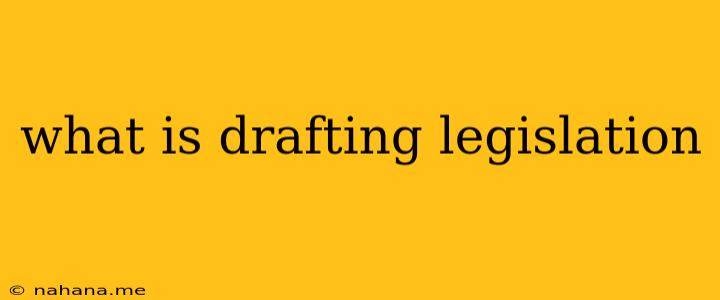What is Drafting Legislation?
The Foundation of Lawmaking
Drafting legislation is the process of creating the legal text of bills, laws, and other legal instruments. It's a crucial step in the lawmaking process, shaping the very foundation of how societies function. This process involves transforming policy ideas into precise and legally sound language, ensuring clarity, consistency, and effectiveness.
Who are the Draftsmen?
Legislation is typically drafted by legal professionals, including:
- Parliamentary Counsel: These are lawyers specifically trained to draft legislation for governments. They have a deep understanding of legal principles, precedents, and the intricacies of legislative language.
- Lawyers in Government Departments: Government departments involved in policy areas often have their own legal teams who draft legislation related to their domains.
- Private Law Firms: Some law firms specialize in drafting legislation for private entities, NGOs, and international organizations.
The Drafting Process: A Multi-Step Approach
Drafting legislation is a complex and iterative process, typically involving these steps:
- Policy Development: The process begins with the identification of a policy issue and the development of a proposed solution.
- Drafting: Legal professionals create the initial draft, using precise language to define scope, obligations, and procedures.
- Consultation: The draft is reviewed by stakeholders, including subject matter experts, government agencies, and the public. Feedback and suggestions are incorporated into the draft.
- Revision and Refinement: The draft undergoes further revisions and refinements based on feedback and legal scrutiny.
- Approval: The final draft is submitted for approval by the relevant legislative body, often through a series of readings and debates.
- Enactment: Once approved, the legislation is formally enacted into law, becoming part of the legal framework.
The Importance of Clarity and Precision
The language used in legislation is crucial. It must be clear, unambiguous, and precise to avoid confusion and ensure the intended effect of the law is realized. Draftsmen use specialized techniques like:
- Defining key terms: Legislation often includes definitions of key terms to ensure consistency and avoid ambiguity.
- Using specific language: Specific terminology, rather than general words, is used to convey precise legal meanings.
- Structuring the text: The legislation is carefully structured to ensure logical flow and clarity.
- Applying legal principles: Drafting incorporates legal principles like separation of powers and due process.
Beyond Words: The Impact of Legislation
Drafting legislation is more than just crafting words. It's about shaping the legal landscape, influencing behavior, and upholding societal values. The precision and clarity of drafting directly affect:
- Citizen rights and obligations: Legislation defines individuals' rights and obligations, impacting daily life and legal processes.
- Government power and authority: Legislation outlines the powers and limitations of government bodies, ensuring checks and balances.
- Economic activity: Laws governing contracts, business, and trade directly influence economic development and activity.
- Social justice and equality: Legislation can promote social justice by addressing discrimination, protecting vulnerable groups, and promoting equal opportunities.
A Continuous Process
Drafting legislation is an ongoing process. Laws are constantly reviewed, amended, or repealed to reflect evolving societal needs and priorities. Understanding the process of drafting legislation provides insights into the foundation of our legal systems and empowers individuals to engage in constructive dialogue about lawmaking.
